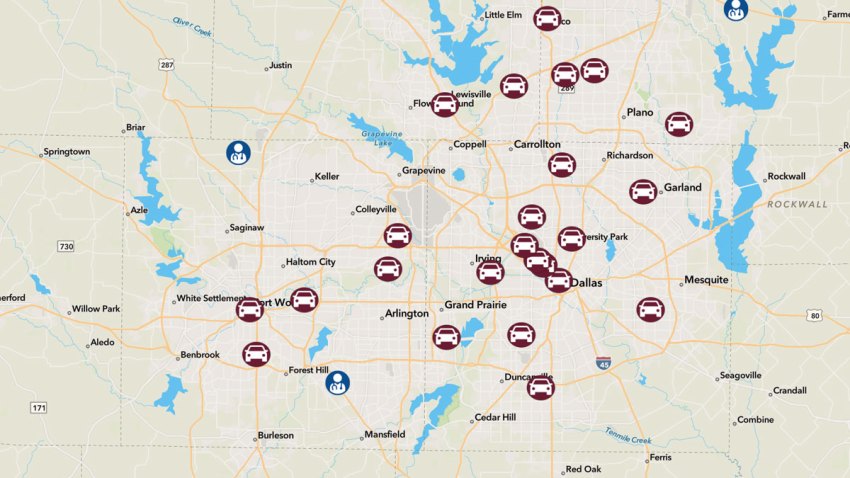For the second straight day, Dallas County is reporting a jump in emergency room visits related to COVID-19 Thursday along with 10 more deaths and 1,201 new confirmed cases of the infection.
Dallas County officials said in a statement Thursday afternoon that “emergency room visits for COVID-19 like symptoms in Dallas County increased to 824 in the 24-hour period ending Wednesday night. A day before, the county reported 786 ER visits over the 24 hour period. The county added there were currently 831 people in acute care being treated for COVID-19 infections, 60 more than on Wednesday.
“Things will get worse before they get better and it’s up to all of us to wear our masks whenever around people outside of our own home,” said Dallas County Judge Clay Jenkins in a statement Thursday. “With the amount of spread in the community, you are much more likely to come into contact with people who are infected than you were during the time when we had shelter in place orders.”
Jenkins urged people to carry masks with them in case they end up around people unexpectedly and to avoid eating in restaurants and going to gyms, day camps, arcades, movie theaters, bowling alleys, amusement parks, concert venues, sporting arenas, youth sports, public pools, weddings or other large events.
Remember, if a member of your household comes down with #COVID19, the entire household will be forced to isolate at home for a minimum of 14 days and potentially longer. Please see the attached document as to the required isolation. pic.twitter.com/4dAkRZZAaQ
— Clay Jenkins (@JudgeClayJ) July 9, 2020
“This is an extremely critical time in our battle against COVID-19. We expect to see more cases in the coming days and how high this surge goes is dependent on each of us doing our part,” said Jenkins said Wednesday.
Ten people whose ages ranged from their 50s to their 90s are among the latest North Texans to die after contracting the virus, they include:
- A Garland man in his 50s with underlying health conditions and who lived in a long-term care facility died after being critically ill in an area hospital.
- A Dallas woman in her 60s who had underlying health conditions and had been hospitalized.
- A Dallas man in his 60s who had underlying health conditions and had been critically ill in an area hospital.
- An Irving man in his 60s with underlying health conditions and had been critically ill in an area hospital.
- A Sunnyvale woman in her 60s who had underlying health conditions and had been critically ill in an area hospital.
- A Dallas woman in her 70s who had underlying health conditions and had been critically ill in an area hospital.
- A Garland man in his 70s who had underlying health conditions and had been critically ill in an area hospital.
- A Dallas woman in her 70s who had underlying health conditions and who died in a hospital emergency room.
- A Dallas man in his 70s who had underlying health conditions and had been critically ill in an area hospital.
- A Dallas man in his 90s who had underlying health conditions and who died at the long-term care facility where he lived.
The 1,201 cases reported Thursday is the seventh-straight day with cases topping 1,000. The 7-day average for new cases is now 1,110 cases per day, up from an average of 209 per day on June 1. In the last week, Dallas County has added 7,771 new cases of the virus.
The county has now accumulated more than 30,300 cases of the virus since testing began in March. There have been 436 deaths attributed in the county to the virus, which, according to Dallas County Health and Human Services Director Dr. Philip Huang, is now the third leading cause of death in the county behind diseases of the heart and cancers.
The increase in cases comes as the state’s positivity rate, the percentage of people testing positive for the virus, has been sustained well over 10% for more than two weeks and grew to just above 15% on Wednesday. An increase in the positivity rate indicates an increase in the spread of the virus, not an increase in testing for the virus.
According to the Texas Department of State Health Services, an estimated 16,192 people (through Thursday) in the county have recovered from the virus leaving an estimated 13,733 known patients fighting the infection.
County officials said last week more than half of the new cases reported have been young adults between the ages of 18 and 39.
To date, of cases requiring hospitalization who reported employment, 83% have been critical infrastructure workers, with a broad range of affected occupational sectors, including healthcare, transportation, food and agriculture, public works, finance, communications, clergy, first responders and other essential functions.
Of cases requiring hospitalization, two-thirds have been under 65 years of age, and about half do not have high-risk chronic health conditions. Diabetes has been an underlying high-risk health condition reported in about a third of all hospitalized patients with COVID-19.
The county has been reporting for several weeks now that more than a third of the deaths related to COVID-19 have been among residents of long-term care facilities.


